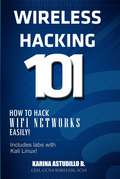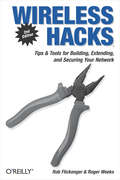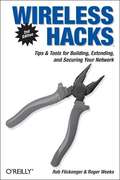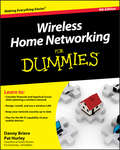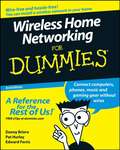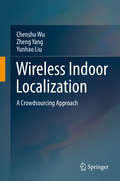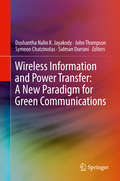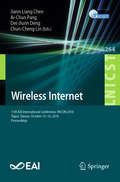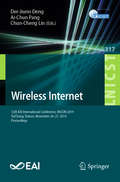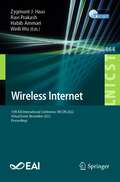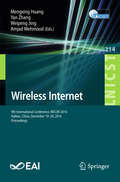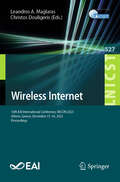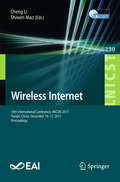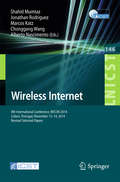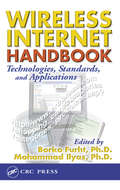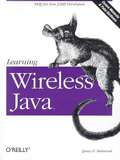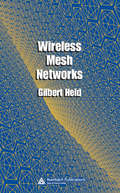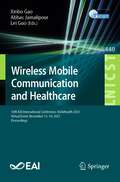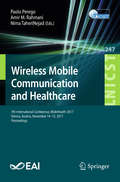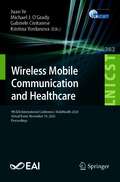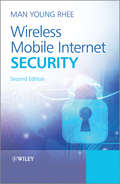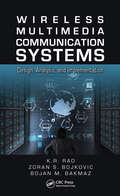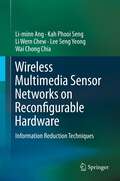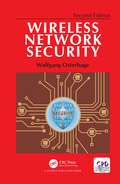- Table View
- List View
Wireless Hacking 101: Piratage éthique des réseaux WiFi sans effort!
by Karina AstudilloWIRELESS HACKING 101 – Piratage éthique des réseaux WiFi sans effort! Ce livre est dédié aux passionnés d'informatique qui cherchent à explorer le monde du piratage éthique et qui veulent se lancer dans les tests d'intrusion sur les réseaux WiFi. Vous y trouverez des informations étape par étape sur la manière d'exploiter les réseaux WiFi à l'aide d'outils inclus dans la populaire distribution Kali Linux, comme la suite aircrack-ng. Sujets traités: Introduction au piratage WiFi En quoi consiste le Wardriving Méthodologie pour un piratage WiFi Analyser les réseaux sans fil Attaquer les réseaux WiFi et ses utilisateurs Contournement du filtrage par MAC Attaques pour les protocoles WEP, WPA, WPA2 Attaques par WPS Création d'un Rogue AP Attaques MITM aux clients WiFi et capture de données Tromper les clients WiFi pour contourner le cryptage SSL Détournement de session des clients WiFi Systèmes de défense
Wireless Hacking 101
by Karina Astudillo Roger WillisWireless Hacking 101 - How to hack wireless networks easily! This book is perfect for computer enthusiasts that want to gain expertise in the interesting world of ethical hacking and that wish to start conducting wireless pentesting. Inside you will find step-by-step instructions about how to exploit WiFi networks using the tools within the known Kali Linux distro as the famous aircrack-ng suite. Topics covered: •Introduction to WiFi Hacking •What is Wardriving •WiFi Hacking Methodology •WiFi Mapping •Attacks to WiFi clients and networks •Defeating MAC control •Attacks to WEP, WPA, and WPA2 •Attacks to WPS •Creating Rogue AP's •MITM attacks to WiFi clients and data capture •Defeating WiFi clients and evading SSL encryption •Kidnapping sessions from WiFi clients •Defensive mechanisms
Wireless Hacks
by Roger Weeks Rob FlickengerThe popularity of wireless networking has grown exponentially over the past few years, despite a general downward trend in the telecommunications industry. More and more computers and users worldwide communicate via radio waves every day, cutting the tethers of the cabled network both at home and at work. Wireless technology changes not only the way we talk to our devices, but also what we ask them to do. With greater flexibility, broader range, and increased mobility, wireless networks let us live, work, and think differently. Wireless networks also open up a vast range of tasty new hack possibilities, from fine-tuning network frequencies to hot-rodding handhelds. The second edition of Wireless Hacks, co-authored by Rob Flickenger and Roger Weeks, brings readers more of the practical tips and tricks that made the first edition a runaway hit, selling nearly 30,000 copies. Completely revised and updated, this version includes over 30 brand new hacks, major overhauls of over 30 more, and timely adjustments and touchups to dozens of other hacks introduced in the first edition. From passive network scanning to aligning long-distance antennas, beefing up wireless network security, and beyond, Wireless Hacks answers real-life networking needs with direct solutions. Flickenger and Weeks both have extensive experience in systems and network administration, and share a passion for making wireless more broadly available. The authors include detailed coverage for important new changes in specifications and in hardware and software, and they delve deep into cellular and Bluetooth technologies. Whether you need your wireless network to extend to the edge of your desk, fit into your backpack, or cross county lines, the proven techniques in Wireless Hacks will show you how to get the coverage and functionality you're looking for.
Wireless Hacks, 2nd Edition
by Rob Flickenger Roger WeeksThe popularity of wireless networking has grown exponentially over the past few years, despite a general downward trend in the telecommunications industry. More and more computers and users worldwide communicate via radio waves every day, cutting the tethers of the cabled network both at home and at work. Wireless technology changes not only the way we talk to our devices, but also what we ask them to do. With greater flexibility, broader range, and increased mobility, wireless networks let us live, work, and think differently. Wireless networks also open up a vast range of tasty new hack possibilities, from fine-tuning network frequencies to hot-rodding handhelds. The second edition of Wireless Hacks , co-authored by Rob Flickenger and Roger Weeks, brings readers more of the practical tips and tricks that made the first edition a runaway hit, selling nearly 30,000 copies. Completely revised and updated, this version includes over 30 brand new hacks, major overhauls of over 30 more, and timely adjustments and touchups to dozens of other hacks introduced in the first edition. From passive network scanning to aligning long-distance antennas, beefing up wireless network security, and beyond, Wireless Hacks answers real-life networking needs with direct solutions. Flickenger and Weeks both have extensive experience in systems and network administration, and share a passion for making wireless more broadly available. The authors include detailed coverage for important new changes in specifications and in hardware and software, and they delve deep into cellular and Bluetooth technologies. Whether you need your wireless network to extend to the edge of your desk, fit into your backpack, or cross county lines, the proven techniques in Wireless Hacks will show you how to get the coverage and functionality you're looking for.
Wireless Home Networking For Dummies
by Danny Briere HurleyThe perennial bestseller shows you how share your files and Internet connection across a wireless networkFully updated for Windows 7 and Mac OS X Snow Leopard, this new edition of this bestseller returns with all the latest in wireless standards and security. This fun and friendly guide shows you how to integrate your iPhone, iPod touch, smartphone, or gaming system into your home network. Veteran authors escort you through the various financial and logisitical considerations that you need to take into account before building a wireless network at home.Covers the basics of planning, installing, and using wireless LANsReviews essential information on the latest security issuesDelivers valuable tips on how to stay current with fast-moving technologyDiscusses how to share resources such as printers, scanners, an Internet connection, files, and more with multiple computers on one networkWireless Home Networking For Dummies, 4th Edition skips the technical jargon and gets you connected with need-to-know information on building a wireless home network.
Wireless Home Networking For Dummies, 3rd Edition
by Danny Briere Pat Hurley Edward FerrisWireless home networks are better than ever! The emergence of new industry standards has made them easier, more convenient, less expensive to own and operate. Still, you need to know what to look for (and look out for), and the expert guidance you'll find in Wireless Home Networks For Dummies, 3rd Edition helps you ensure that your wire-free life is also a hassle-free life! This user-friendly, plain-English guide delivers all of the tips, tricks, and knowledge you need to plan your wireless home network, evaluate and select the equipment that will work best for you, install and configure your wireless network, and much more. You'll find out how to share your Internet connection over your network, as well as files, printers, and other peripherals. And, you'll learn how to avoid the "gotchas" that can creep in when you least expect them. Discover how to: Choose the right networking equipment Install and configure your wireless network Integrate Bluetooth into your network Work with servers, gateways, routers, and switches Connect audiovisual equipment to your wireless network Play wireless, multiuser computer games Establish and maintain your network's security Troubleshoot networking problems Improve network performance Understand 802. 11n Whether you're working with Windows PCs, Mac OS X machines, or both Wireless Home Networking For Dummies, 3rd Edition, makes it fast and easy to get your wireless network up and running-and keep it that way!
Wireless Indoor Localization: A Crowdsourcing Approach
by Chenshu Wu Zheng Yang Yunhao LiuThis book provides a comprehensive and in-depth understanding of wireless indoor localization for ubiquitous applications. The past decade has witnessed a flourishing of WiFi-based indoor localization, which has become one of the most popular localization solutions and has attracted considerable attention from both the academic and industrial communities. Specifically focusing on WiFi fingerprint based localization via crowdsourcing, the book follows a top-down approach and explores the three most important aspects of wireless indoor localization: deployment, maintenance, and service accuracy. After extensively reviewing the state-of-the-art literature, it highlights the latest advances in crowdsourcing-enabled WiFi localization. It elaborated the ideas, methods and systems for implementing the crowdsourcing approach for fingerprint-based localization. By tackling the problems such as: deployment costs of fingerprint database construction, maintenance overhead of fingerprint database updating, floor plan generation, and location errors, the book offers a valuable reference guide for technicians and practitioners in the field of location-based services. As the first of its kind, introducing readers to WiFi-based localization from a crowdsourcing perspective, it will greatly benefit and appeal to scientists and researchers in mobile and ubiquitous computing and related areas.
Wireless Information and Power Transfer: A New Paradigm for Green Communications
by Salman Durrani Symeon Chatzinotas John Thompson Dushantha Nalin K. JayakodyThis book presents breakthroughs in the design of Wireless Energy Harvesting (WEH) networks. It bridges the gap between WEH through radio waves communications and power transfer, which have largely been designed separately. The authors present an overview of the RF-EHNs including system architecture and RF energy harvesting techniques and existing applications. They also cover the idea of WEH in novel discoveries of information, the theoretical bounds in WEH, wireless sensor networks, usage of modern channel coding together with WEH, energy efficient resource allocation mechanisms, distributed self-organized energy efficient designs, delay-energy trade-off, specific protocols for energy efficient communication designs, D2D communication and energy efficiency, cooperative wireless networks, and cognitive networks.
Wireless Internet: 11th EAI International Conference, WiCON 2018, Taipei, Taiwan, October 15-16, 2018, Proceedings (Lecture Notes of the Institute for Computer Sciences, Social Informatics and Telecommunications Engineering #264)
by Jiann-Liang Chen Ai-Chun Pang Der-Jiunn Deng Chun-Cheng LinThis book constitutes the refereed post-conference proceedings of the 11th International Conference on Wireless Internet , WiCON 2018, held in Taipei, Taiwan, in October 2018. The 36 full papers were selected from 79 submissions and are grouped into the following topics: wireless network, artificial intelligence, security, IoT, location-based services, financial applicatiosn, vehicular ad hoc network, services and applications.
Wireless Internet: 12th EAI International Conference, WiCON 2019, TaiChung, Taiwan, November 26–27, 2019, Proceedings (Lecture Notes of the Institute for Computer Sciences, Social Informatics and Telecommunications Engineering #317)
by Der-Jiunn Deng Ai-Chun Pang Chun-Cheng LinThis book constitutes the refereed post-conference proceedings of the 12th International Conference on Wireless Internet, WiCON 2019, held in TaiChung, Taiwan, in November 2019. The 39 full papers were selected from 79 submissions and are grouped into the following topics: Ad hoc and sensor network, artificial intelligence, security and blockchain, internet of things, wireless internet, services and applications.
Wireless Internet: 15th EAI International Conference, WiCON 2022, Virtual Event, November 2022, Proceedings (Lecture Notes of the Institute for Computer Sciences, Social Informatics and Telecommunications Engineering #464)
by Zygmunt J. Haas Ravi Prakash Habib Ammari Weili WuThis book constitutes the refereed post-conference proceedings of the 15th International Conference on Wireless Internet, WiCON 2022, held in November 2022. Due to COVID-19 pandemic the conference was held virtually. The 16 full papers were selected from 45 submissions and are grouped into the following topics: Security and privacy; blockchain and wireless networks; Resource management, routing, and internet computing; social networks and learning.
Wireless Internet
by Mengxing Huang Yan Zhang Weipeng Jing Amjad MehmoodUbiquitous and pervasive technologies such as RFID and smart computing promise a world of networked and interconnected devices. Everything from tires to toothbrushes could soon be in communications range, heralding the dawn of an era in which today's Internet of Peoplegives way to tomorrow's Internet of Things-- where billions of objects will have the ability to report their location, identity, and history over wireless connections. Connectivity and Communication -- Anything, Anywhere, and Anytime An examination of the exciting expansion period in this research, TheInternet of Things: From RFID to the Next-Generation Pervasive Networked Systemsprovides comprehensive, technical, and practical deploying policy guidance that covers fundamentals and recent advances in pervasive networked systems. The book addresses the conceptual and technical issues that influence the technology roadmap and gives an in-depth introduction to the Internet of Thingsand its effect on businesses and individuals. Discussing case studies, experience reports, and best practice, it contains information on emerging technologies, market opportunities, and policy implications. Practical Guidance and Balanced Coverage The first book of its kind to address major new technological developments and define the Internet of Things, this text provides balanced coverage of theory and practical issues. Reflecting research trends and industry needs, itis a comprehensive technical and practical guide to recent advances in pervasive networked systems.
Wireless Internet: 16th EAI International Conference, WiCON 2023, Athens, Greece, December 15-16, 2023, Proceedings (Lecture Notes of the Institute for Computer Sciences, Social Informatics and Telecommunications Engineering #527)
by Leandros A. Maglaras Christos DouligerisThis book constitutes the refereed post-conference proceedings of the 16th International Conference on Wireless Internet, WiCON 2023, held in Athens, Greece, in December 15-16, 2023. The 14 full papers were selected from 35 submissions and are grouped into the following topics: Wireless networks; AI/ML systems; 5G/6G networks; and Digital services.
Wireless Internet: 10th International Conference, Wicon 2017, Tianjin, China, December 16-17, 2017, Proceedings (Lecture Notes of the Institute for Computer Sciences, Social Informatics and Telecommunications Engineering #230)
by Shiwen Mao Cheng LiThis book constitutes the refereed post-conference proceedings of the 10th International Conference on Wireless Internet , WiCON 2017, held in Tianjin, China, in December 2017. The 42 full papers were selected from 70 submissions and cover the following topics: wireless networking, massive MIMO and mmWave, WSNs and VANETs, security and IoT, wireless communications, cloud and big data networking.
Wireless Internet
by Shahid Mumtaz Jonathan Rodriguez Marcos Katz Chonggang Wang Alberto NascimentoThis book constitutes the thoroughly refereed post-conference proceedings of the 8th International Conference on Wireless Internet, WICON 2014, held in Lisbon, Portugal, in November 2014. The 45 revised full papers were carefully reviewed and selected from numerous submissions. The papers cover topics such as 5G mobile communications, Internet of Things (IoT), super Wi-Fi and V2V/V21.
Wireless Internet Handbook: Technologies, Standards, and Applications (Internet And Communications)
by Borko Furht and Mohammad IlyasWireless applications are definitely the next big thing in communications. Millions of people around the world use the Internet every day - to stay in touch with remote locations, follow the stock market, keep up with the news, check the weather, make travel plans, conduct business, shop, entertain themselves, and learn. The logical next step is th
Wireless Java
by Qusay MahmoudLearning Wireless Java is for Java developers who want to quickly come up to speed and create applications for the Micro Edition audience. This book covers the Connected, Limited Device Configuration and the Mobile Information Device Profile (MIDP), both currently available from Javasoft. The CLDC contains APIs for small devices that are constrained by both memory and processing power. MIDP builds on top of the CLDC and adds APIs specifically for devices such as mobile phones and pagers, allowing programmers to create MIDlet applications. This book offers a solid introduction to J2ME and MIDP, including an explanation of the J2ME Wireless Toolkit, the MIDlet lifecycle methods, the Java application manager, and the CLDC and MIDP constraints. In addition, we cover the javax.microedition.io, javax.microedition.rms, javax.microedition.lcdui, and javax.microedition.midlet classes, as well as the modified java.lang, java.io, and java.util classes. Discussion centers around building safe, compact applications with the sophisticated graphical interface, database, and networking capabilities that the J2ME supports. In addition, this book also shows you how to download your applications to the latest J2ME-enabled devices, including the Motorola i50x and i85s phones and upgraded Palm handhelds.
Wireless Mesh Networks
by Gilbert HeldWireless mesh networking is a new technology that has the potential to revolutionize how we access the Internet and communicate with co-workers and friends. Wireless Mesh Networks examines the concept and explores its advantages over existing technologies. This book explores existing and future applications.
Wireless Mobile Communication and Healthcare: 10th EAI International Conference, MobiHealth 2021, Virtual Event, November 13–14, 2021, Proceedings (Lecture Notes of the Institute for Computer Sciences, Social Informatics and Telecommunications Engineering #440)
by Xinbo Gao Abbas Jamalipour Lei GuoThis book constitutes the refereed post-conference proceedings of the 10th International Conference on Mobile Communication and Healthcare, MobiHealth 2021, held in November 2021. Due to Covid-19 pandemic the conference was held virtually.
Wireless Mobile Communication and Healthcare: 7th International Conference, Mobihealth 2017, Vienna, Austria, November 14-15, 2017, Proceedings (Lecture Notes of the Institute for Computer Sciences, Social Informatics and Telecommunications Engineering #247)
by Nima TaheriNejad Amir M. Rahmani Paolo PeregoThis book constitutes the refereed post-conference proceedings of the 7th International Conference on Mobile Communication and Healthcare, MobiHealth 2017, held in Vienna, Austria, in November 2017. The 34 revised full papers were reviewed and selected from more than 50 submissions and are organized in topical sections covering data analysis, systems, work-in-process, pervasive and wearable health monitoring, advances in healthcare services, design for healthcare, advances in soft wearable technology for mobile-health, sensors and circuits.
Wireless Mobile Communication and Healthcare: 9th EAI International Conference, MobiHealth 2020, Virtual Event, November 19, 2020, Proceedings (Lecture Notes of the Institute for Computer Sciences, Social Informatics and Telecommunications Engineering #362)
by Juan Ye Michael J. O’Grady Gabriele Civitarese Kristina YordanovaThis book constitutes the refereed post-conference proceedings of the 9th International Conference on Mobile Communication and Healthcare, MobiHealth 2020, held in December 2020. Due to Covid-19 pandemic the conference was held virtually. The book contains 13 full papers selected from the main conference and 10 full papers from two workshops on medical artificial intelligence and on digital healthcare technologies. The conference papers are organized in topical sections on wearable technologies; health telemetry; mobile sensing and assessment; machine learning in eHealth applications.
Wireless Mobile Internet Security
by Man Young RheeThe mobile industry for wireless cellular services has grown at a rapid pace over the past decade. Similarly, Internet service technology has also made dramatic growth through the World Wide Web with a wire line infrastructure. Realization for complete wired/wireless mobile Internet technologies will become the future objectives for convergence of these technologies through multiple enhancements of both cellular mobile systems and Internet interoperability. Flawless integration between these two wired/wireless networks will enable subscribers to not only roam worldwide, but also to solve the ever increasing demand for data/Internet services. In order to keep up with this noteworthy growth in the demand for wireless broadband, new technologies and structural architectures are needed to greatly improve system performance and network scalability while significantly reducing the cost of equipment and deployment. Dr. Rhee covers the technological development of wired/wireless internet communications in compliance with each iterative generation up to 4G systems, with emphasis on wireless security aspects. By progressing in a systematic matter, presenting the theory and practice of wired/wireless mobile technologies along with various security problems, readers will gain an intimate sense of how mobile internet systems operate and how to address complex security issues. Features: Written by a top expert in information security Gives a clear understanding of wired/wireless mobile internet technologies Presents complete coverage of various cryptographic protocols and specifications needed for 3GPP: AES, KASUMI, Public-key and Elliptic curve cryptography Forecast new features and promising 4G packet-switched wireless internet technologies for voice and data communications Provides MIMO/OFDMA-based for 4G systems such as Long Term Evolution (LTE), Ultra Mobile Broadband (UMB), Mobile WiMax or Wireless Broadband (WiBro) Deals with Intrusion Detection System against worm/virus cyber attacks The book ideal for advanced undergraduate and postgraduate students enrolled in courses such as Wireless Access Networking, Mobile Internet Radio Communications. Practicing engineers in industry and research scientists can use the book as a reference to get reacquainted with mobile radio fundamentals or to gain deeper understanding of complex security issues.
Wireless Multimedia Communication Systems: Design, Analysis, and Implementation
by K.R. Rao Zoran S. Bojkovic Bojan M. BakmazRapid progress in software, hardware, mobile networks, and the potential of interactive media poses many questions for researchers, manufacturers, and operators of wireless multimedia communication systems. Wireless Multimedia Communication Systems: Design, Analysis, and Implementation strives to answer those questions by not only covering the underlying concepts involved in the design, analysis, and implementation of wireless multimedia communication systems, but also by tackling advanced topics such as mobility management, security components, and smart grids. Offering an accessible treatment of the latest research, this book: Presents specific wireless multimedia communication schemes that have proven to be useful Discusses important standardization processing activities regarding wireless networking Includes wireless mesh and multimedia sensor network architectures, protocols, and design optimizations Highlights the challenges associated with meeting complex connectivity requirements Contains numerous figures, tables, examples, references, and a glossary of acronyms Providing coverage of significant technological advances in their initial steps along with a survey of the fundamental principles and practices, Wireless Multimedia Communication Systems: Design, Analysis, and Implementation aids senior-level and graduate-level engineering students and practicing professionals in understanding the processes and furthering the development of today’s wireless multimedia communication systems.
Wireless Multimedia Sensor Networks on Reconfigurable Hardware
by Li-Minn Ang Kah Phooi Seng Li Wern Chew Lee Seng Yeong Wai Chong ChiaTraditional wireless sensor networks (WSNs) capture scalar data such as temperature, vibration, pressure, or humidity. Motivated by the success of WSNs and also with the emergence of new technology in the form of low-cost image sensors, researchers have proposed combining image and audio sensors with WSNs to form wireless multimedia sensor networks (WMSNs). This introduces practical and research challenges, because multimedia sensors, particularly image sensors, generate huge amounts of data to be processed and distributed within the network, while sensor nodes have restricted battery power and hardware resources. This book describes how reconfigurable hardware technologies such as field-programmable gate arrays (FPGAs) offer cost-effective, flexible platforms for implementing WMSNs, with a main focus on developing efficient algorithms and architectures for information reduction, including event detection, event compression, and multicamera processing for hardware implementations. The authors include a comprehensive review of wireless multimedia sensor networks, a complete specification of a very low-complexity, low-memory FPGA WMSN node processor, and several case studies that illustrate information reduction algorithms for visual event compression, detection, and fusion. The book will be of interest to academic researchers, R&D engineers, and computer science and engineering graduate students engaged with signal and video processing, computer vision, embedded systems, and sensor networks.
Wireless Network Security: Second Edition
by Wolfgang OsterhageWireless communications have become indispensable part of our lives. The book deals with the security of such wireless communication. The technological background of these applications have been presented in detail. Special emphasis has been laid on the IEEE 802.11x-standards that have been developed for this technology. A major part of the book is devoted to security risks, encryption and authentication. Checklists have been provided to help IT administrators and security officers to achieve the maximum possible security in their installations, when using wireless technology. This is the second edition of the book. The updates include the latest the IEEE 802.11-standard, an updated chapter on PDA, the increased relevance of smart phones and tablets, widespread use of WLAN with increased security risks.

